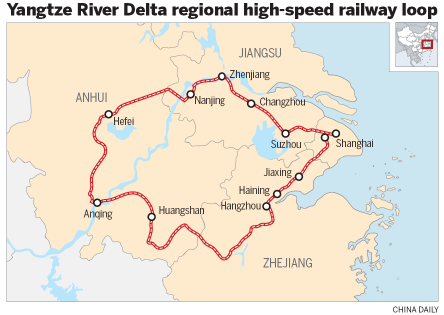
Yangtze River Delta High-Speed Rail Loop (China Daily)
China will unveil a revised national railway timetable on Saturday, introducing a series of improvements aimed at enhancing the country's strategic interests and promoting regional socio-economic development.
A notable addition to the new schedule is the opening of the high-speed rail circle line connecting Shanghai with the provinces of Zhejiang, Jiangsu and Anhui. Spanning more than 1,200 kilometers, the line starts from Shanghai Railway Station in the city center, connects major cities such as Suzhou, Nanjing, Hangzhou and Huangshan, and returns to Shanghai Hongqiao Railway Station.
Operated by high-speed train G8388, the circular line departs Shanghai at approximately 10:30am and arrives in Shanghai Hongqiao at approximately 6:30pm. The circular line covers 21 stations and crosses several popular tourist cities in the Yangtze River Delta region.
The circular line will connect seven high-speed rail lines in the region, according to China Railway Shanghai Group, which operates the line, and will also link outlying towns with major cities.
The adjusted schedule aims to promote a seamless travel and tourism experience in the Yangtze River Delta region, and provide more travel options from Beijing and Shanghai to Hong Kong.
Another prominent feature of the new timetable is the introduction of faster high-speed trains linking Beijing with China's southern province of Guangdong and neighbouring Hong Kong.
On the Beijing-Guangzhou high-speed railway, high-speed trains will run at 350 kilometers per hour, shortening travel time between the two cities to 7 hours and 16 minutes, 22 minutes shorter than before.
In 2022, the Beijing-Guangzhou High-Speed Railway resumed high-speed train service between Beijing and Wuhan in Hubei province at a speed of 350 km/h, but maintained a speed of 300 km/h between Wuhan and Guangzhou.
Faster sleeper trains to Hong Kong are also set to begin operation from Beijing and Shanghai, expected to offer cross-border passengers a refined travel experience and streamline journeys between Hong Kong and mainland China.
The introduction of the faster sleeper trains will halve the travel time between Beijing and Hong Kong to 12.5 hours, and cut the travel time between Shanghai and Hong Kong from more than 19.5 hours to around 11 hours. Both sleeper trains will depart in the evening and arrive at their destinations by morning.
China's rail industry typically adjusts train schedules quarterly to meet passenger needs.
John Lin, 40, from Hong Kong, said the high-speed rail was a preferred mode of travel for families with young children who find air travel inconvenient.
Lin welcomed the faster departure and arrival times for daytime flights between Beijing and Hong Kong, saying the longer journeys would allow passengers to take more time to rest on board.
“The departure and arrival times of high-speed trains are very accommodating. A departure at 10 a.m. is not too early and an arrival at 6 p.m. is not too late,” he said. “It's okay to take a break on board at midday. An eight-hour train journey is acceptable as long as the train is clean.”
He said his home is close to Hong Kong's West Kowloon station, making long-distance train travel convenient.
Although the train ticket price was a little higher than discounted off-peak airfare, Lin said the eight-hour journey on a clean train was a comfortable one.
Zhang Lulin, a Beijing native studying in Hong Kong, said bringing some entertainment with her helped her pass the time on the 10-hour train journey between the two cities.
“It was 10 hours, so I think it would be a good idea to have some movies or books on board to pass the time,” she said.
Chan said he plans to take the train again, as West Kowloon station is a convenient place to transfer to the subway to get to the university.
“Taking the train is a good option as long as you can keep yourself busy on the train,” she said.





